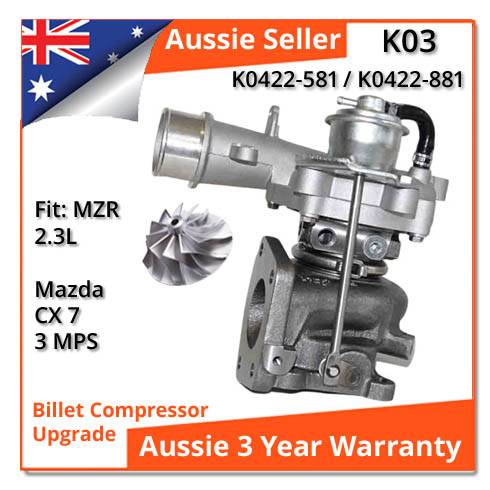Dealing With Mazda CX7 Turbo Problems – When Replacement Is Imminent
The Mazda CX-7 is popular across the US, Europe, Asia, and Aussie. The USA market absorbed 180,000 cars between 2006 and 2012. Peaking in 2007 with more than 41,000 vehicles sold, being twice as many as the average between 2006 to 2012.
Japanese auto-makers are known for reliability, but there have been problems with the CX7 turbo that were not addressed. A common issue is found in the turbocharger on the 4 cylinder, 2.3 liter gasoline engine. Operating at full load, the engine output with turbocharger is 256 HP and 380 Nm of torque. These are high performance figures for a mid range SUV. But, when the turbo fails, power is dramatically reduced. And turbo failure is common in the Petrol CX-7.
This results in:
♦ Less acceleration
♦ Sluggish turbo spool-up response
♦ Lower top end speed and power
♦ The top speed takes forever to reach, if at all.
Why Does The CX7 Turbo Fail?
Like most turbochargers, the list of common problems that can lead to turbo component failure is quite varied, but there are a few more common with the CX7 turbo.
Let’s look at 3 of the most common reasons:
1. Lubrication
Turbos spin up to 200,000 rpm, so require a constant flow of clean oil. This helps to lubricate and cool components shielding them from excessive wear. Thus failure to regularly check and fully replace the oil and filter in your CX7, with quality oil will cause carbon build-up inside the turbocharger and associated system, such as oil feed line and banjo bolts.
Contaminants cause damage to the inner working parts of the turbo, reducing its useful life, eventually leading to complete failure of the entire turbo.
Tip: use a quality fully-synthetic oil, and change oil and filter every 5000km or less in a CX7 turbo, to decrease the chance of complete failure.
2. Alien objects
Foreign matter creates a risk to your CX7 turbo. As mentioned above, fast moving parts are susceptible to massive damage when a foreign object limits oil flow or suddenly blocks moving part movement.
Mazda’s Official Position
The usual, early symptom of a failing turbocharger isn’t lack of power, but white smoke from the vehicle’s exhaust system. This is often followed by a drop in performance.
Mazda’s official position has targeted vehicle owners. Dealerships have considered sludge buildup as a result of poor maintenance, thus causing the turbo to fail. In some cases this is true, but as the CX-7 is very susceptible to sludge in the oil system and bottlenecks in small diameter oil system turbo feed components, it needs very regular maintenance.
But one online case report showed that Mazda technicians did admit a problem with the turbocharger’s oil lubrication system, causing failure. However, overall Mazda has failed to acknowledge CX-7 turbo issues.
How to Fix A Mazda CX7 Turbo Failure?
Short answer: You don’t. Turbochargers need to be completely replaced.
Note: It is highly important to maintain your vehicle with timely oil and filter changes to reduce the possibility of turbo damage.
Replacement Mazda CX-7 Turbocharger
![]() Need to replace a CX-7 2.3L Turbo:
Need to replace a CX-7 2.3L Turbo:
Check-out Our Cost-effective Replacement 2.3L CX-7 Turbochargers HERE
![]() Need help with another Turbo:
Need help with another Turbo:
Contact Us on 0490 059 316
Save
Save
Save
Save
Save
Save
Save
Save
Save
Save
Save
Save
Save
Save
Save
Save
Save
Save
Save
Save
Save
Save
Save
Save
Save
Save
Save
Save
Save
Save
Save
Save
Save
Save
Save
Save
Save
Save
Save
Save
Save
Save
Save
Save
Save
Save
Save
Save
Save
Save
Save
Save
Save
Save
Save
Save
Save
Save
Save
Save

